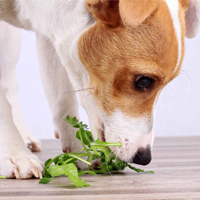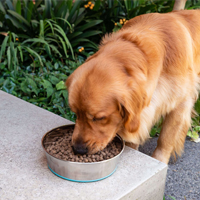
Comfrey for Dogs and How to Use it Safely
Comfrey is truly one of our favorite herbs for dogs that we have used safely for ourselves and our own pets over the years. In this article, we hope to give you a better understanding of the controversy surrounding the safety of comfrey.
This herb offers incredible healing benefits to both people and pets. Every part of the plant including the roots, leaves, stem, etc. provide medicinal benefits.
Why the Regulations on Comfrey
Take a look at the nicknames for comfrey: Knitbone, All Heal, Healherb and Woundwort. These names alone should tell you alot about what our ancestors thought of this herb.
So why the regulations? Apparently it started with Australia in 1978 reporting that this herb contains pyrrolizidine alkaloids (PA’s) and causes liver damage and cancer. Unfortunately, they placed it on a poison advisory list in 1984 with several other countries following suit. In 2002 the U.S. banned comfrey supplements for internal use.
From what we understand, there was never any human testing done and the testing done on baby rats was typical. The Horono Study fed the baby rats unrealistic amounts of comfrey daily that would never be consumed by people or pets on a regular basis. They did this for 600 days. 28 of the rats were fed 8% dry comfrey roots and leaves and after 600 days, only ONE showed a liver tumor.
After this study, comfrey was bombarded with negative press. It’s no different than garlic which too was a result of bad press with regards to its nutritional value for dogs. You’ll find hundreds of stories about how bad garlic is for dogs and that’s simply not true unless excessive over the top amounts are fed daily ongoing. With this said, there are precautions for certain breeds, anemic dogs, dogs going into surgery and so forth. Learn more about the precautions of garlic for dogs here.
The bottom line is this. If your dog has liver disease, then simply don’t feed comfrey internally. Our own dogs literally jump when we reach for the comfrey container. They lick it off of the spoon.
Testimonials About Comfrey Safety and Animals
“Foster Savage, who takes credit for introducing comfrey into Australia in 1954, fed it to his stock in great quantities (and ate quite a bit of it himself.) He found that milk production increased dramatically in his cows, with the bonus of thick cream. He also fed his pigs as much comfrey as they could eat and the quality of his meat became legendary. His butcher remarked that he had never seen pigs with such healthy livers.”
“I’ve not seen evidence of an animal harmed by Comfrey. All the testimonials I’ve read are by people who’ve had great results, including people who examine the livers whenever they harvest a chicken, looking for irregularities. Posted on Backyard Chickens”
Our dog had two torn ACL’s. One big part of therapy we used for her was to applying comfrey salve to both ACL’s for roughly 8 months daily in addition to using a good brace from Orthodog. Just the other day someone actually commented about how well she is doing and said “didn’t she have 2 torn ACL issues? She’s walking great!” I said “yes she is!” Janie, YourOldDog
“I’ve fed my rabbits, ducks, chickens and goats comfrey for almost 20 years as a supplemental food. I never lost an animal in those years other than varmints killing them or old age and snakes. I had the healthiest ducks, chickens and goats you could have.” Posted on Horses and Pet Health
I urge you to read the comments at the bottom of the article here. You will hear from many pet owners who share incredible stories about using comfrey.
What is Comfrey Best Known For?
Animals naturally self medicate and have an acute sense of what is good for them and how much. That is worth emphasizing. Many consider comfrey to be a miracle plant. It is best known for it’s ability to speed the healing process and is one of the few plants that is naturally high in vitamin B12.
B12 is typically found in agricultural products such as eggs, meat and liver. Native Americans recognized the therapeutics of comfrey early on and used it as one of their main therapeutics. This study provides some excellent insight into the incredible benefits of comfrey which can be used for ourselves and our dogs.
Here’s what comfrey has been known to help with:
- Bone fractures
- Torn ligaments and tendons
- Cuts
- Abrasions
- Bruises
- Burns
- Swelling
- Pain
- Myalgia
- Osteoarthritis
- Spider bites (poisonous brown recluse)
- Hernia’s
Applying Comfrey to Dogs
You should be diligent and use comfrey daily on your dog for whatever the ailment is that you’re trying to heal. Something as simple as a cut, bruise or swelling could heal in days. However, something more serious could take 9 months to a year. To use it sporadically, will not provide the same benefits. If a poultice is too much for you to work with, you can also use a good comfrey salve made from roots and leaves for your dog, but this could be costly. A good example of a salve is this one.
DIRECTIONS FOR MAKING A POULTICE:
- Gather a small handful of fresh or dried comfrey roots and leaves.
- Place in the dried herb into a zip lock bag. Using your hands, crush the dried herb by simply squeezing the bag.
- Once crushed, place in a bowl deep enough to cover with boiling water.
- Using a spoon, mash the mixture into a pulp.
- Allow the pulp to cool and then spread directly onto the affected area.
- Cover with gauze and bandage to hold in place. Leave in place for 3-4 hours a day if possible.
- Don’t allow your dog to eat it. Afterall, you’re trying to heal the area and we need the comfrey to stay in place in order to work its magic.
Like our friend calendula, comfrey is used to speed wound healing and diminish the amount of pain at the healing site. This is because of substances like allantoin, rosmarinic acid, and tannins, which help produce new skin. Because comfrey can help stimulate cell growth, it can work wonders on wounds, scrapes, tissue and ligament tears when applied as an ointment, massage oil or poultice over the skin.
Using Comfrey Internally
The comfrey leaf contains roughly 0.3% PA total. The root contains ten times more PA than the leaves. To remain on the safe side, even though the study cited above done on rats clearly explains that negative results appeared only with one rat out of 28 that developed a liver tumor while using a large PA percent of 0.8 of the leaves and roots for 600 days (close to 20 months), only use the leaf internally and not the root.
Preventative Measures Using Comfrey for Dogs
- The biggest problem with comfrey extract benefits is the large amount of hepatotoxic pyrrolizidine alkaloids. Again, you can refer to the above Horono Study and the testimonials from others that I cited above in order to come to your own conclusion.
- Avoid using comfrey internally for dogs with liver disease.
- Comfrey should not be used by pregnant or lactating animals and should be avoided by pets with a history of liver disease.
References: Your Old Dog, Herbs for Pets by M.L. Wulff-Tilford and G.L. Tilford, Natural Remedies for Dogs and Cats by CJ Puotinen










